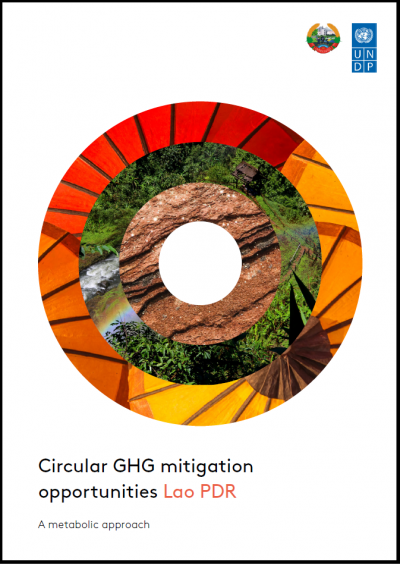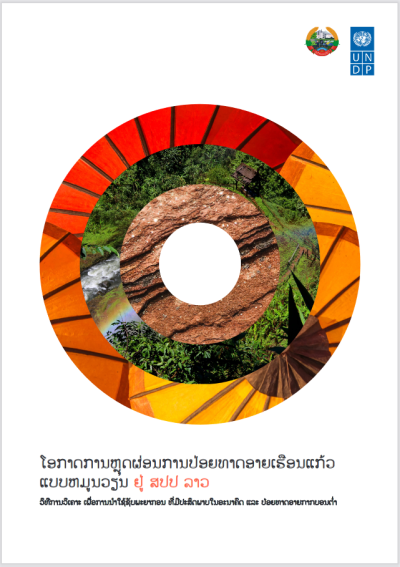A metabolic analysis and broad stakeholder engagement process brought 17 interventions to the surface. Together, they can turn Lao PDR into a net carbon sink by 2040. 82% of the circular GHG mitigation and sequestration potential has a payback below 2.5 years.
Lao PDR has a unique opportunity to take a leading role on circular economy and low carbon development in Southeast Asia. The country has an abundance of resources. Its fertile soils support large forestry and agricultural systems, while deposits of gold, copper, zinc, lead, tin, iron, aluminium, potash, limestone, gypsum and coal lie beneath them. Located at the crossroads of three major Asian economies – China, Vietnam and Thailand – the country is surrounded by large and demanding markets. It serves them primarily through the extraction and export of raw materials such as metal ores, wood and electricity from hydropower.
Specifically that position and the trade relations which Lao PDR maintains, allows it to lead the pack in the transition to a circular economy. By exporting green products and reducing the import of carbon-intensive products, Lao PDR can encourage its regional trade partners to jointly embark on the transition to green future.
Lao PDR’s most recent Paris pledge or Nationally Determine Contribution (NDC) aims to reach net carbon neutrality by 2050. This project examined how supplementing the NDC with 17 circular economy greenhouse gas (GHG) mitigation and sequestration interventions can contribute to achieving or, even, raising that ambition. It also presents the business cases supporting these interventions for the private sector in Lao PDR.
Net carbon neutral by 2040 within reach
Lao PDR can become net carbon neutral by 2040 by adopting a circular economy approach. With the measures proposed in the NDC, it can reduce its GHG footprint from 106 to 58 million tCO2e/year in 2040. The circular GHG mitigation interventions can reduce it further to net zero.
Most of the circular mitigation and sequestration potential that is commercially viable lies in wood-based construction; improving livestock efficiency; prioritizing active, shared, public and electric transport; reducing food losses; industrial symbiosis and remanufacturing. By adopting circular economy strategies, Lao PDR would also reduce the import of carbon-intensive products. This creates additional GHG emission reductions with Lao’s foreign trade partners of approximately 2.2 million tCO2e/year.
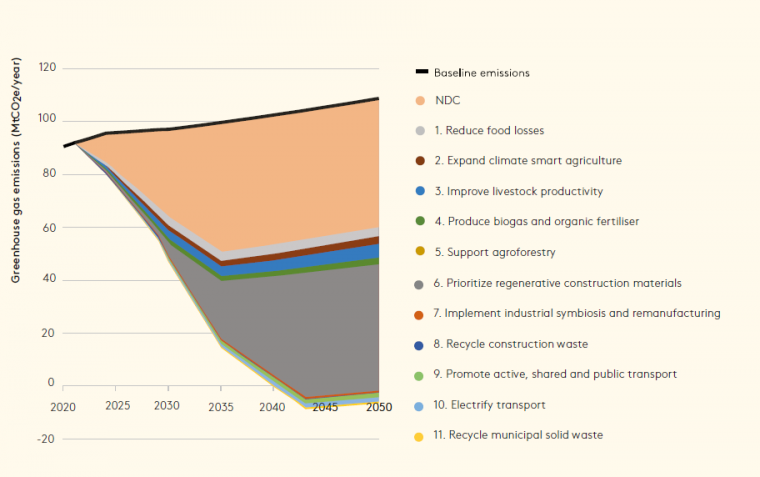
The circular economy has a GDP potential of $16 billion per year
These interventions can reduce solid waste disposal by 86 percent and reduce an additional 2.6 million tonnes of food waste and losses. The gross domestic product (GDP) from the circular economy in Lao PDR could reach $16 billion by 2050, while the number of jobs in the circular economy could reach 1.6 million by 2050. The Lao PDR workforce totalled 3.9 million in 2020, of which around 16 percent in circular jobs.
89% of the mitigation potential has a positive NPV
According to business case estimates, the circular economy is a viable business opportunity for Lao PDR. Eighty-nine percent of the circular GHG mitigation and sequestration potential has a positive net present value and 85 percent provides a payback in less than six years. When introducing a carbon price of $25 per tonne, 98 percent of the circular mitigation and sequestration potential has a positive return, or negative marginal abatement costs. Without a carbon price, that percentage is 89 percent.
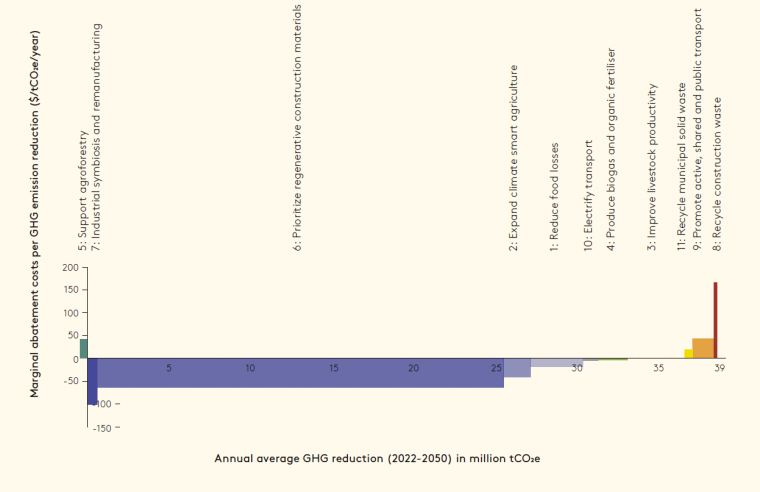
Circular GHG mitigation requires a $4.1 billion investment
The transition to a circular, net zero carbon economy requires an investment of $4.1 billion in the period 2022-2036. That is in addition to the $4.7 billion which is required between 2020 and 2030 to implement the NDC. In comparison, Boten-Vientiane railroad, which is schedule for commissioning in December 2021, required an investment of $5.95 billion. To realize investments in a low-carbon and circular future, regulatory and institutional barriers must be overcome for circular ventures so that they have access to investment capital, for example.
The metabolic analysis explained
Lao PDR is one of the first countries to adopt a metabolic approach to identify commercially viable opportunities to combine climate action with improving resource efficiency. In the metabolic analysis 332 materials flows were analysed. The extraction of materials and their disposal has an impact on the quality of natural assets and their ability to serve current and future generations alike. The metabolic approach shifts the focus from environmental issues and short-term priorities to the performance of the overall system and its ability to provide societal needs like housing, nutrition and mobility in a low-carbon and resource-efficient manner.
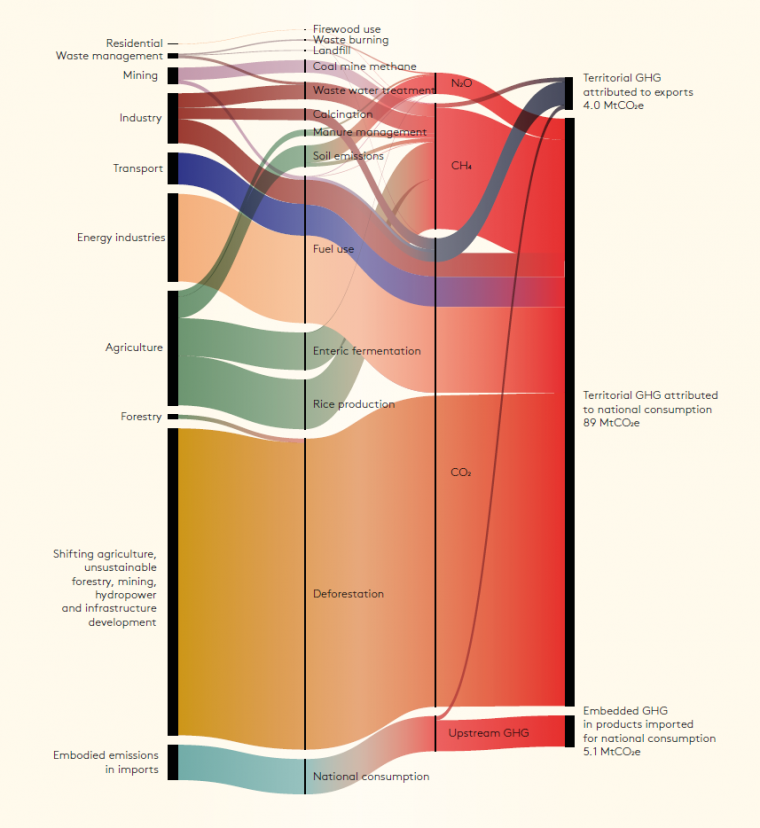
The result is 17 interventions. Eleven core interventions intervene directly in the material flows of food value chains, the construction sector and industry. Six additional interventions can be considered as ‘enabling’ as they support the transition to a circular economy in Lao PDR by targeting public services and policies, commercial services, and financial services. Most of the circular mitigation and sequestration potential lies in wood-based construction, improving livestock efficiency, prioritizing active, shared, public and electric transport and reducing food losses.
More information is available in a blog post from UNDP, on the Community of Practice, in Transform Magazine and at KPL Lao News Agency.
Project partners
The project was led by Shifting Paradigms from The Netherlands in collaboration with Earth Systems (Lao PDR), Rebel Group (the Netherlands), DFDL (Lao PDR) and Circle Economy (the Netherlands). The project was commissioned by UNDP and realised thanks to the generous support of the European Union, the governments of Germany and Spain under the UNDP NDC support programme.
About UNDP
UNDP’s work on climate change spans more than 140 countries and US$3.7 billion in investments in climate change adaptation and mitigation measures since 2008. With the goal to foster ambitious progress towards resilient, zero-carbon development, UNDP has also supported implementation of the Paris Agreement on Climate Change by working with countries to achieve their climate commitments or Nationally Determined Contributions (NDCs).
The UNDP NDC Support Programme
The NDC Support Programme provides technical support for countries to pursue a ‘whole-of-society’, integrated approach that strengthens national systems, facilitates climate action and increases access to finance for transformative sustainable development. The programme helps countries address these financial barriers by deploying a structured approach for scaling up sectoral investments and putting in place a transparent, enabling investment environment. Beyond direct country support, UNDP facilitates exchanges and learning opportunities on nationally determined contribution implementation at the global and regional level by capitalizing on our close collaboration with the UNFCCC and other strategic partners.
The Programme, which works in contribution to the NDC Partnership, is generously supported by the German Federal Minister for the Environment, Nature Conservation, and Nuclear Safety (BMU), the German Federal Ministry of Economic Cooperation and Development (BMZ), the European Union and the Government of Spain.

